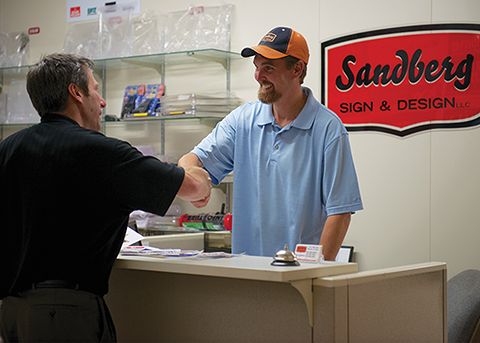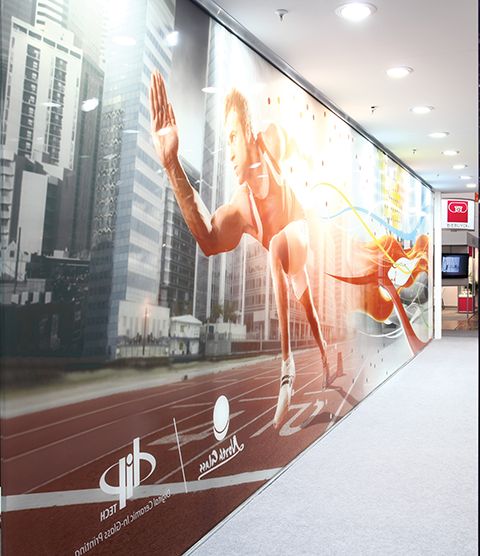Wide-format Printing: Developments in the sign and display market
by all | 23 July 2015 9:25 am
 [1]
[1]By Sarit Tichon
All indications suggest the worldwide sign, display and wide-format printing market continues to grow. While there is plenty of optimism, however, sign and display professionals should pay attention to major changes in the industry, as new strategies will be needed for further success. This is particularly true in niche markets where new technologies have made inroads.
Replacing equipment
One of the major changes that have faced the industry in recent years is a growing emphasis on ‘green’ issues. The environmental impact of print production is affecting the decisions made by an increasing number of sign, display and large-format print buyers.
In turn, this is affecting sales of new printing equipment. Both ultraviolet-curing (UV-curing) and durable aqueous ‘latex’ inkjet printers continue to change the landscape by replacing earlier solvent-based printers that outgassed volatile organic compounds (VOCs). Sign shops have needed to watch these trends closely when investing in new equipment.
That said, not all of their older equipment is necessarily obsolete yet. Worldwide data shows 56 per cent of all signmaking jobs still involve vinyl cutting, for instance. This may surprise many people, but even after 20 years, digital printing has added to the overall sign and display market, rather than replacing traditional methods as it was anticipated to do.
There are still beneficial characteristics of cut vinyl, including its depth of colour and its resistance to weather and abrasion. And many signage jobs simply call for lettering, with no need for printers or inks. For these jobs, letter cutting is fast and the pieces are easily mounted.
Working with digital signage
Digital signage may also appear to pose a threat to traditional graphics, given its growing prevalence in supermarkets, airports, shopping malls, sports venues, train stations and elsewhere—but again, it is more of a supplemental technology than a replacement. Digital screens are most effective where they can display information that changes, while static signs remain the best and most cost-effective way to display information that does not change.
It is not uncommon to see a screen surrounded by printed graphics. This can be a powerful combination, providing both static information and changeable messages, and the trend is likely to grow.
 [2]
[2]Non-traditional markets
Some non-traditional markets for large-format printing are growing rapidly, thanks to new innovations in technology.
In particular, new inkjet systems have been developed for textile, ceramic and glass printing. And while much of the industry’s textile printing involves soft signage, apparel printing is also becoming a major component of this type of work.
Other growth areas include packaging and labels, where many businesses are looking to work with fewer suppliers. At the same time, large-format print shops are targeting new revenue streams by striving to do more work for their existing customers.
There has also been enormous interest in three-dimensional (3-D) printing, giving rise to predictions of a surge in additive manufacturing carried out by consumers themselves. The real future of 3-D printing is more likely to involve locally produced short runs of custom applications like packaging. This could be a great opportunity for sign shops, for which folding carton and other packaging-focused design software has been developed in recent years.
Differentiation through specialization
There has also been a transformation at the supply end of the sign and display business. Many manufacturers have started to offer ‘all-in-one’ systems, bringing together printers, inks, software and substrates into the same package for the production of a certain type of application, e.g. traffic signs or interior décor wallcoverings. Similar systems are likely to be developed for the aforementioned non-traditional markets: textile, ceramic and glass printing.
While all of these systems promise to make signmakers’ jobs easier in the future, the most successful will be those signmakers who can differentiate themselves by establishing a strong reputation for providing at least one specialized type of application. While the sign, display and large-format graphics businesses are all growing and full of further potential, the need to add value and differentiate is key to everyone’s success.
Sarit Tichon is senior vice-president (SVP) of worldwide sales for SAi, which provides design, pre-press and production software for the signmaking, digital printing, screenprinting and computer numerical control (CNC) machining industries. For more information, visit www.thinksai.com[3].
- [Image]: http://www.signmedia.ca/wp-content/uploads/2015/07/Optimism-and-signs-of-growth-are-evident-within-the-market-says-Tichon.jpg
- [Image]: http://www.signmedia.ca/wp-content/uploads/2015/07/Typical-applications-of-digital-ceramic-printing-include-color-printed-architectural-glass-for-interior-projects.jpg
- www.thinksai.com: http://www.thinksai.com
Source URL: https://www.signmedia.ca/wide-format-printing-developments-in-the-sign-and-display-market/